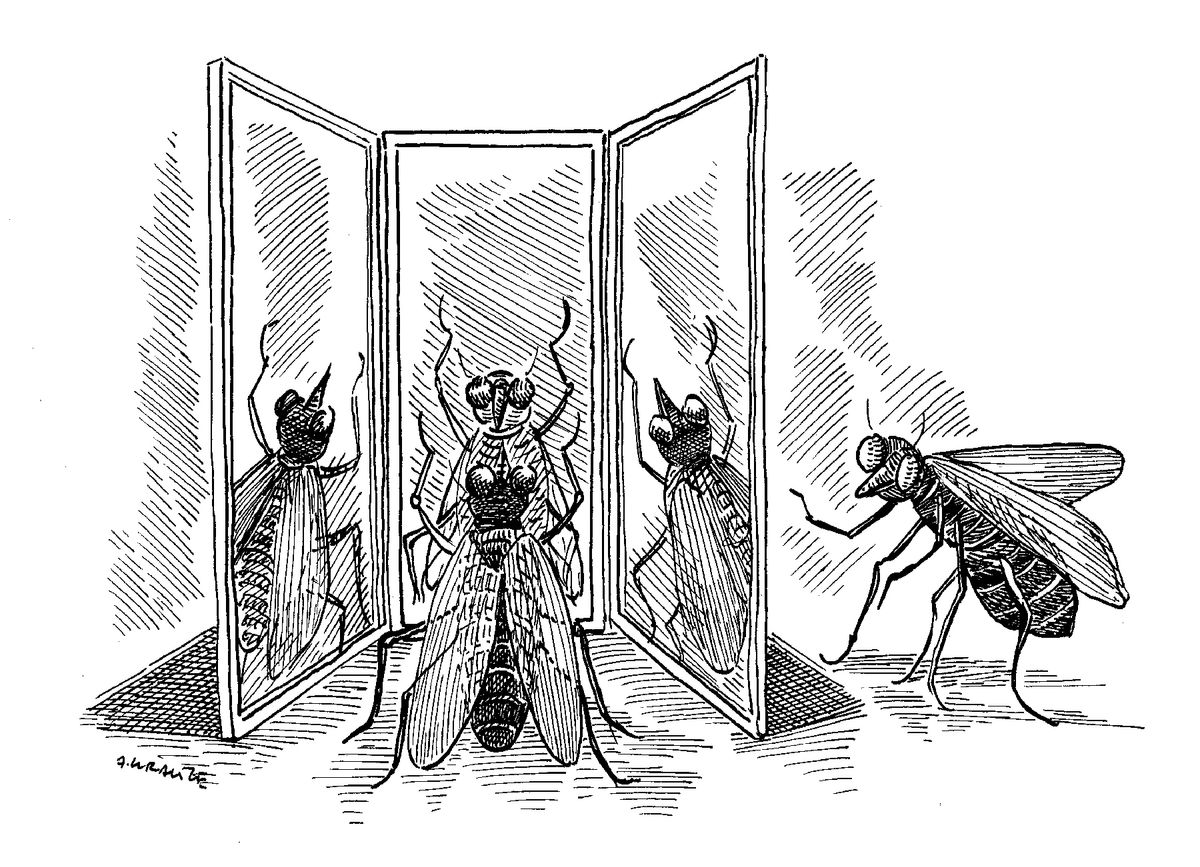ABOVE: Drosophila melanogaster © ISTOCK.COM, JANEFF
For females of many species, choosing a mate is a weighty decision. You want your offspring to inherit the best possible genes. But how do you judge the genetic quality of a potential mate?
Around 50 years ago, an idea emerged that the extent of deviation from perfect bilateral symmetry—that is, the difference between an animal’s right and left sides—could indicate genetic quality. Researchers hypothesized that individuals with high-quality genes would be better buffered against stress and instability during development, and thus more likely to turn out symmetric. In order to maximize fitness, then, females should opt for more-symmetric partners.
In the 1980s and ’90s, numerous studies across different species tested whether females consider symmetry when choosing a mate. However, these studies produced mixed results, according to Roshan Kumar Vijendravarma, a biologist at the Institut Jacques Monod in Paris. He says that efforts to experimentally induce asymmetry (which included clipping feathers, adding colored rings to the feet, and increasing stresses like temperature during development) often had confounding effects on survival, growth, and behavior. In other words, these studies were unable to separate asymmetry from other factors affecting fitness.
If both wings are equally shaped, each should generate similar sounds.
Eventually, with questions still unanswered, the research buzz around the symmetry-based hypothesis of sexual selection died down. Until, that is, Vijendravarma recently decided to revisit the issue as a postdoc in the lab of Pierre Leopold at the Institut Curie in Paris. Their paper, published in March in PNAS, is “clearly an improvement on most or all previous studies in this area,” says Laurent Keller, a biologist at the University of Lausanne in Switzerland who was not involved in the study.
Vijendravarma was able to overcome the challenges that had plagued previous attempts with a novel method of inducing asymmetry, which he deployed in Drosophila melanogaster. After unsuccessful attempts at producing wonky fly larvae with the usual ecological stressors, he discovered that altering the direction of gravity with a vertically rotating apparatus reliably disrupted symmetric development. In particular, it influenced the wing area in adults, producing a pool of research subjects whose wings ranged from near-perfect mirror images to very asymmetric but who were otherwise indistinguishable—the treatment had no obvious detrimental effects. “The males were all viable and they all reproduced. We were able to uncouple asymmetry from bad quality,” he says.
Vijendravarma and his colleagues then randomly selected pairs of males raised in altered gravity to compete for a female. Most females opted for males that were more symmetric, the team found. The researchers also performed genetic and surgical manipulations on flies to alter their wing symmetry. While these experiments would not be definitive on their own due to the confounding factors that also plagued earlier studies, they could provide supporting evidence to the results from the gravity experiments, Vijendravarma says. Sure enough, no matter how the wings got to be uneven, females preferred more symmetric males.
“The methodology is beautiful,” says Marla Sokolowski, a biologist at the University of Toronto who was not involved in the study. “I think it’s a rigorous study, right down to the way the flies were reared, housed, and handled. . . . They came up with almost everything one could think of to induce this asymmetry.”
Vijendravarma’s second innovation was to look beyond the sense of sight. It struck him that although the literature was full of studies where females were expected to assess the symmetry of males visually, the courtship of most animals is multimodal. Female fruit flies, for instance, use olfactory and auditory cues in addition to visual ones during courtship. Through which of these senses do they perceive asymmetry?
Conducting mate choice experiments under red light, so the females couldn’t see, did not make a difference to their behavior, nor did removing their scent-sensitive antennae. However, making the females deaf by removing their antennal sound receptors, or aristae, caused them to lose their preference for symmetric males.
Vijendravarma consequently turned his attention to the Drosophila courtship songs, which males produce by extending and vibrating one wing at a time. If both wings are equally shaped, each should generate similar sounds. But if they are asymmetric, the difference would be reflected in the song, Vijendravarma reasoned. Sure enough, analysis of left wing– and right wing–generated sounds revealed that rejected males with asymmetric wings sang songs that varied in amplitude and frequency.
“On the face of it, the data are quite convincing,” says Michael Ritchie, a biologist at the University of St Andrews who was not involved in the study. However, he says some might be skeptical of whether the study really demonstrates that females evaluate symmetry as a measure of male quality. “There’s nothing in the paper about variation in genetic quality. It’s an artificially constructed developmental aberration,” he says. “The question is, does natural variation in genetic quality influence male asymmetry, and would females discriminate against males based on that level of asymmetry?”

Keller also wonders about how females may benefit from choosing a symmetric mate. “It would be interesting to allow females to choose males based on symmetry and then compare the fitness of the offspring,” he says.
In future work, Vijendravarma plans to investigate the link between asymmetry and genetic quality, as well as how altered gravity leads to asymmetry. But he and Leopold also hope to inspire other researchers to think more broadly about asymmetry and sexual selection. In a recent review paper, the pair attempts to address science’s bias toward visual cues by highlighting the many ways that females of different species may assess symmetry nonvisually. “The idea is that we need to think more about the ecology of the animal before setting up these types of experiments, rather than impose our own biases onto them,” says Vijendravarma.
The authors list auditory, chemosensory, and mechanosensory cues evaluated by females and speculate about how these signals could be affected by asymmetry in physical features such as pheromone glands or legs. They further propose that the structures built for courtship by males of some species, such as the bowers of bowerbirds and nests of certain fish, could amplify minute levels of asymmetry in the builder.
“The review is full of useful, fascinating ideas,” says Ritchie. “I think this deserves to stimulate more work, and it probably will.”








